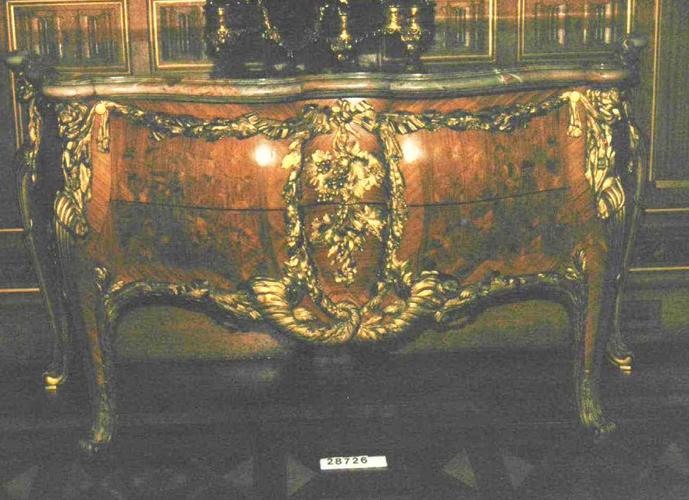Commode c. 1880 - 1900
94.0 x 171.5 x 71.0 cm (whole object) | RCIN 28726
-
This commode dates from the late nineteenth to early twentieth centuries, but is highly influenced by commodes produced in France during the eighteenth century, during the reign of Louis XV. Although seemingly unmarked, it is very much in the manner of other known works by the celebrated ebeniste Francois Linke.
Linke was one of the most distinguished cabinetmakers of the late 19th and early 20th centuries. From his premises in the fashionable Faubourg Saint Antoine district of Paris, his workshop produced a wide range of furniture of the finest quality. The workshop's early output was characterised by pieces in the Louis XV and Louis XVI styles, with 18th century examples produced during the 'ancien regime' - including those of Jean-François Oeben and Jean-Henri Riesener - offering a rich source of inspiration. By the turn of the century, Linke had moved from reproducing works by the 'old masters' to develop his own unique style, combining elements of the rococo with the latest fashions in art nouveau, to create what became termed 'le style Linke'. Linke's work was met with critical acclaim at the 1900 Exposition Universelle, Paris, where he was awarded a gold medal.
The design for this commode derives from the side aspect of the celebrated bureau du roi - the roll-top desk commissioned by King Louis XV from Jean-François Oeben and completed by his former apprentice, Jean-Henri Riesener, which was delivered to the King's cabinet intérieur (private study) at Versailles in 1769 (Versailles inv. no. OA 5444). The reeded leg mounts entwined with foliage and surmounted by lion-pelts, as well as the distinctive cornucopia and tied swags of laurel framing a central oval, all feature on the bureau du roi. Another desk, also by Riesener, originally made for the Comte d'Orsay and now in the Wallace Collection, London, features comparable lion-pelt mounts (F102). The same design is repeated on the side of a writing table made some seventeen years later by Riesener's successor, Guillaume Beneman, for Louis XVI's cabinet intérieur at Versailles and intended as a companion to his grandfather's celebrated desk (Waddesdon Manor acc no. 2575).
The commode originally formed one of a pair. The companion piece was sold as part of the sale of 'Furniture and works of Art from Marlborough House' conducted by Christie Manson & Woods on 1st and 2nd Oct 1959. Lot 179 notes:
'A LARGE MARQUETRY COMMODE, of Louis XV design, with serpentine-shaped front, fitted with two deep drawers, inlaid in various woods with bouquets of flowers and mounted with elaborate ormolu borders to the panels, corner plaques and toes cast and chased with riband ties suspending branches and laurel foliage and lions' masks and manes on scroll feet, surmounted by a veined mottled grey marble slab – 66in. wide'
It is not yet known how, and at what time, the commodes first entered the Royal Collection. The present example bears the stamp of 'White Allom and Co' – a decorating firm patronised, in particular, by Edward VII, Queen Alexandra and Queen Mary.
The first definite reference occurs in 1914 when the pair were photographed in the 'Tapestry Drawing Room', Buckingham Palace, in the private apartments of Queen Mary (RCIN 1114823). One of the pair features prominently in the background of a series of autochrome portraits of George V, Queen Mary and Edward, Prince of Wales, taken by the photographer Jean Desboutin, in the same location, on 13th March 1914, and subsequently published by 'L'illustration' (RCIN's 2084611; 2084636 - 2084644 & 2946198-2946200)
By 1937 both commodes (as well as many other furnishings from the tapestry drawing room) had moved to Marlborough House where one was photographed in the Green Drawing Room (RCIN 2102061; 2102067; 2102068), and its pair in the Saloon (RCIN 2102043). More recently, the commode which remains in the Royal Collection has been displayed in the Robing Room of the Palace of Westminster.
Comparable examples sold Sotheby's, New York, 15 December 1984, lot 33 and Christie's, London, 14 May 1998, lot 262.
Literature
Christopher Payne, François Linke 1855-1946: The Belle Epoque of French Furniture, (London, 2003)Provenance
Probably purchased by Edward VII, Queen Alexandra or Queen Mary. In the Tapestry Drawing Room, Buckingham Palace, by 1914. In either the Green Drawing Room or Saloon, Marlborough House, by 1937. Its pair sold 1959.
-
Creator(s)
-
Medium and techniques
Measurements
94.0 x 171.5 x 71.0 cm (whole object)
Category









